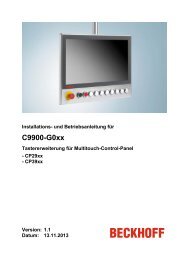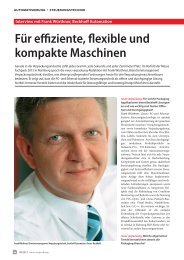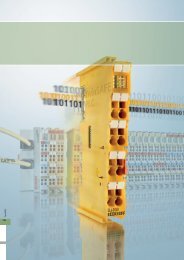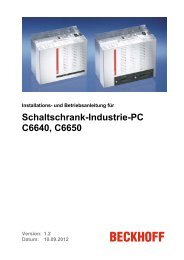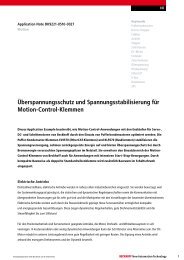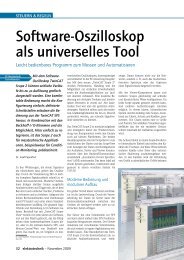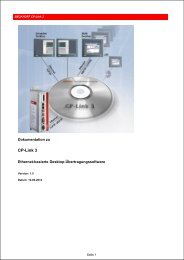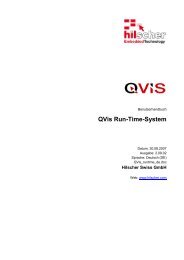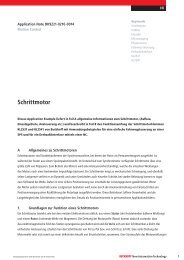SERCOS Coupler BK7500 - download - Beckhoff
SERCOS Coupler BK7500 - download - Beckhoff
SERCOS Coupler BK7500 - download - Beckhoff
You also want an ePaper? Increase the reach of your titles
YUMPU automatically turns print PDFs into web optimized ePapers that Google loves.
Basic information<br />
Digital signals<br />
(bit-oriented)<br />
Analog signals<br />
(byte-oriented)<br />
Special signals and<br />
interface<br />
Default assignment of<br />
inputs and outputs to the<br />
process image<br />
The peripheral data in the process image<br />
When the bus coupler is first switched on it determines the configuration of<br />
the attached input/output terminals and automatically assigns the physical<br />
slots of the input/output channels to the addresses in the process image.<br />
The bus coupler sets up an internal list of assignments in which each of the<br />
input and output channels has a specific position in the process image. A<br />
distinction is made here between input and output and between bit-oriented<br />
(digital) and byte-oriented (analog, or complex) signal processing.<br />
It also forms two groups, whereby one contains only inputs and the other<br />
only outputs. In each group, the byte-oriented channels take the lowest<br />
addresses, in ascending order, and these are then followed by the bitoriented<br />
channels.<br />
Digital signals are bit-oriented. This means that one bit of the process<br />
image is assigned to each digital channel. The bus coupler sets up a block<br />
of memory containing the current input bits and arranges to immediately<br />
write out the bits from a second block of memory which belongs to the<br />
output channels.<br />
The precise assignment of the input and output channels to the process<br />
image of the control unit is explained in detail in the Appendix by means of<br />
an example.<br />
The processing of analog signals is always byte-oriented and analog input<br />
and output values are stored in memory in a two-byte representation. The<br />
values are held as "SIGNED INTEGER” or "twos-complement”. The digit<br />
"0” represents the input/output value "0V”, "0mA” or "4mA”. When you use<br />
the default settings, the maximum value of the input/output value is given<br />
by "7FFF” hex. Negative input/output values, such as -10V, are<br />
represented as "8000” hex and intermediate values are correspondingly<br />
proportional to one another. The full range of 15-bit resolution is not<br />
realized at every input/output level. If you have an actual resolution of 12<br />
bits, the remaining three bits have no effect on output and are read as "0”<br />
on input. Each channel also possesses a control and status byte in the<br />
lowest value byte. If the control/status byte is mapped in the control unit<br />
has to be configured in the master configuration software. An analog<br />
channel is represented by 2 bytes user data in the process image.<br />
The <strong>BK7500</strong> bus coupler supports bus terminals with additional interfaces,<br />
such as RS232, RS485, incremental encoder, etc.. These signals can be<br />
regarded in the same way as the analog signals described above. A 16-bit<br />
data width may not be sufficient for all such special signals; the bus coupler<br />
can support any data width. With regard to accessing these values, please<br />
ensure that data consistency is safeguarded. That is to say, do not send<br />
any "update" command between access operations and do not switch the<br />
bus coupler to "freewheeling" mode.<br />
When the bus coupler is first switched on it determines the number of<br />
attached bus terminals and sets up a list of assignments. This list<br />
distinguishes between analog channels and digital channels and between<br />
input and output; which are grouped separately. The assignments begin<br />
immediately to the left of the bus coupler. The software in the bus coupler<br />
creates the assignment list by collecting the entries for the individual<br />
channels one at a time, counting from left to right. These assignments<br />
distinguish four groups:<br />
14 <strong>BK7500</strong>





